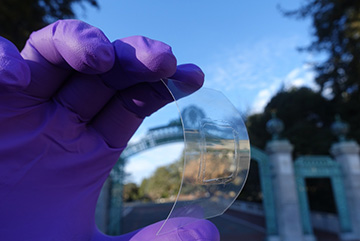
A team of U.S. scientists found that slightly bending atomically thin LED semiconductors can allow them to emit light at near 100% efficiency—and to avoid the efficiency roll-off with increasing brightness that usually plagues these LEDs. [Image: Ali Javey/Berkeley Lab]
Light-emitting diodes (LEDs) have revolutionized the world many times over, in areas ranging from smartphone screens to low-energy lighting. But LED efficiency often degrades as brightness increases—a problem that’s particularly vexing for a family of new, intriguing 2D semiconductor materials, the so-called transition-metal dichalcogenides (TMDs). The significant efficiency roll-off for these atomically thin materials at high brightness has held them back from use in practical applications.
Now, researchers at the University of California, Berkeley, and the Lawrence Berkeley National Laboratory, USA, may have found a remarkably simple way around the efficiency roadblock for these LEDs (Science, doi: 10.1126/science.abi9193). The team has shown that applying a mechanical strain of less than 1% to a TMD can change the material’s electronic structure enough to allow near-100% light emission efficiency (that is, photoluminescence quantum yield), even at high brightness levels. The result, the team believes, could enable a new generation of LED devices that avoid efficiency erosion as brightness increases.
Exciton–exciton annihilation
In all organic and some inorganic LEDs, efficiency roll-off at high brightness has its roots in a phenomenon called exciton–exciton annihilation (EEA). When an energy source such as an electric current or laser beam excites a semiconductor, it kicks negatively charged electrons from the semiconductor’s valence band into its conductance band, leaving positively charged electron holes behind. In a semiconductor with the right properties, the electron–hole pair remains bound as a neutral quasiparticle known as an exciton. Subsequent radiative recombination of the electron and hole in the exciton results in the emission of a photon, giving rise to the LED’s emission of visible light.
At low exciton densities, virtually all excitons have the elbow room to recombine radiatively, and TMD LEDs can sport quantum yields of nearly 100%. But as the LED brightness—and, hence, the density of excitons—increases, the excitons start to collide and wipe each other out, leading to nonradiative decay, or EEA, that’s dissipated as heat. Result: the roll-off in photoluminescence efficiency with increased brightness that plagues these ultrathin materials.
The amount of nonradiative EEA depends in large part on the details of the semiconductor’s band structure. For TMD semiconductors in particular, the Berkeley team discovered, the amount of EEA is enhanced by van Hove singularities—tiny kinks in the semiconductor’s energy structure that boost the density of states (the number of possible energy states available for occupation) at that point.
Stretching for efficiency
To get around the problem of EEA at high exciton densities, the Berkeley researchers worked on ways to tweak the TMD material’s band structure. They found that applying a uniaxial strain—literally, slightly stretching the material—did the trick nicely.
In their experiments, the team mounted a number of different TMDs, including monolayers of WS2, WSe2, and MoS2, onto a flexible plastic substrate, adding layers of hexagonal boron nitride (as a gate insulator) and graphene (as a gate electrode). The researchers then applied a voltage bias to the device, excited the material with a laser beam to create excitons, and measured the photoluminescence quantum yield of the material as the laser intensity (and, thus, the exciton density) was increased.
The team found that for the unstrained TMD, as expected, quantum yield decayed as the exciton density increased. Slightly bending the flexible substrate to impose a tensile strain of only 0.2% in the TMD, however, led to a noticeable decrease in the amount of the roll-off. And with a tensile strain of 0.4%, there was effectively no efficiency roll-off at high brightness, with the material maintaining photoluminescence quantum yields of nearly 100% regardless of exciton density.
Efficiency roll-off banished?
The team’s analysis suggests that the strain’s impact on quantum yield relates to the presence of “saddle points” in the semiconductor’s band structure—analogous to mountain passes in its energy landscape. In the unstrained material, the saddle points, which are areas of van Hove singularities, lie near the favored energy for exciton–exciton annihilation, and thus serve to intensify the level of EEA. Slightly bending the material reshapes the band structure, moving the saddle points sufficiently so that the van Hove singularities don’t favor EEA. That, in turn, allows more excitons to recombine radiatively—and boosts the photoluminescence quantum yield.
While most of the team’s experiments involved mechanically exfoliated flakes of various 2D materials, the researchers were also able to demonstrate the beneficial effect of strain on the quantum yield of a large-area (centimeter-scale) slice of WS2 grown by the much more scalable process of chemical vapor deposition. That additional finding, the researchers believe, points to the prospect of a new generation of LEDs unplagued by efficiency erosion at high brightness levels.
“These single-layer semiconductor materials,” said team leader Ali Javey in a press release accompanying the research, “are intriguing for optoelectronic applications, as they uniquely provide high efficiency even at high brightness levels and despite the presence of large number of imperfections in their crystals.”
